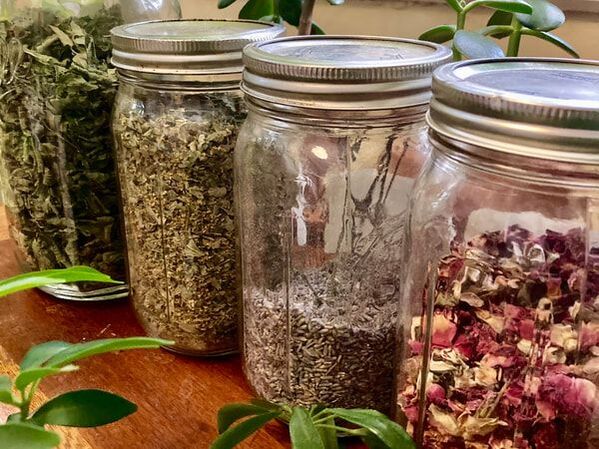|
I love making tea. The ritual of it is grounding, and it can feel almost like a divination--a Oija board type experience. Here’s what I mean: when I open up my cupboard of herbs, I let my hands decide. Which herbs will they choose? I try to keep my mind out of the way as much as possible. My hands do the measuring too: a pinch of this, a handful of that. No two pots of tea are ever the same. I do, however, tend to go through phases where I used the same herbs over and over in various combinations.
Lately, my life has been characterized by transition and change. I’ve found that heart-centered nervine herbs ease tension in my chest and soothe my mind. Here are some of my favorite herbs for tea right now (and maybe always, to be honest): Rose- the queen of all flowers, the most luxurious and delicate of scents, the very symbol of love and of the heart. Rose is wonderful for the emotional heart as well as the physical. As a cooling, astringent nervine, rose soothes cardiovascular inflammation and calms a racing heart. Rose also eases heartbreak. Tulsi- another queen, to be sure. Tulsi is one of my favorite herbs. Of all time. I feel noticeably more relaxed and focused when I drink tulsi tea. And if I drink tulsi regularly, I find that my mood is more stable and I am generally more calm and collected. Melissa- the fruity, lemony flavor of this herb brightens my day, uplifting my spirit. For me, Melissa is like rose-colored glasses in a cup. I feel a little lighter and more cheerful when she is around. Hawthorn leaf- Like rose herself, hawthorn is another rose family herb. It is no wonder that hawthorn, too, is wonderful for the emotional and physical heart. Linden- I couldn’t talk about calming nervines for the heart without mentioning linden. In Burlington, Vermont, linden is one of the most cherished scents of the summer months. In mid June, after the apple trees and lilacs have long since lost their fragrant blossoms, a sweet smell wafts all over town on warm sunny days. Behold the sweet, fragrant medicine of the linden flower. Drinking linden blossoms in winter transports me to the Summer and evokes feelings of hope and joy. My tea blends have evolved over time, and I gain experience with each new pot I brew. I love discovering new combinations of herbs, and learning how each herb influences my mind and body when I drink it regularly. Like everything in herbalism, experience comes with time. The key is not being afraid to play around. I’ve made some pretty disgusting tea blends along the way, but more often I’ve made surprisingly magical blends that I can return to again and again. Here is a basic recipe for making any herbal infusion. This works bester for leaves and flowers. For woodier parts of a plant, like bark, roots, and seed pods, a decoction will be the best way to make a tea. Herbal Infusion Ingredients 2-3 TBS dried or fresh herbs of your choice. This can be a single herb or multiple herbs 1 quart near-boiling water Instructions
What are your favorite herbs to drink as tea?
0 Comments
|
AuthorHerbalist, artist, woodland wanderer Archives
March 2021
Categories
All
|
Proudly powered by Weebly

 RSS Feed
RSS Feed